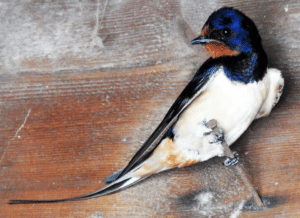
UPDATED
Dec. 3, 2018
Congratulations to the Italian team on the publication of their European barn swallow genome! The paper is now available at GigaScience.
ORIGINAL POST
Oct. 3, 2018
With its bold blue plumage, russet throat and chipper chirps, the barn swallow is beloved by many avian enthusiasts. It’s also a favorite of scientists, becoming a flagship species for conservation biology. Numerous evolutionary and ecological studies have focused on its biology, life history, sexual selection, response to climate change, and the divergence between its eight subspecies in Europe, Asia and North America.
But the full potential of such studies has been limited by gaps in genomic data. A 2016 draft genome for the American subspecies (Hirundo rustica erythrogaster), for example, was assembled from short, paired-end reads derived from a male individual, leading to continuity gaps and a lack of information for the W chromosome, as females are the heterogametic (ZW) sex in birds.
To address such limitations, an international team of researchers from the University of Milan, University of Pavia, and California State Polytechnic University used SMRT Sequencing at the Functional Genomics Center in Zurich and Bionano optical mapping to produce a new high-quality genome assembly for the European barn swallow, Hirundo rustica rustica.
The combination led to a final 1.21 Gb assembly with a scaffold N50 value of over 25.95 Mb, representing a more than 650-fold improvement in N50 with respect to the 2016 draft genome, as reported in the pre-print “SMRT long-read sequencing and Direct Label and Stain optical maps allow the generation of a high-quality genome assembly for the European barn swallow (Hirundo rustica rustica).”
The primary assembly’s contiguity metrics even meet the high standards of the Vertebrate Genome Project consortium “Platinum Genome” criteria (contig N50 in excess of 1 Mb and scaffold N50 above 10 Mb).
“Given the inception of large scale sequencing initiatives aiming to produce genome assemblies for a wide range of organisms, it is critical to identify combinations of sequencing and scaffolding approaches that allow the cost effective generation of genuinely high-quality genome assemblies,” the authors write.
“We believe that the data presented here, as well as attesting to the effectiveness of SMRT sequencing combined with DLS optical mapping for the assembly of vertebrate genomes, will provide an invaluable asset for population genetics studies in the barn swallow and for comparative genomics in birds,” they conclude.
The authors also identified several potential future projects based on the improved assembly, including: the phasing of the assembly to generate extended haplotypes, a more thorough gene annotation using RNA/Iso-Seq sequencing data, detailed comparisons with genome data from the American barn swallow, re-evaluation of data from previous population genetics studies conducted in this species, as well as characterization of the epigenetic landscape.
We look forward to additional reports, and will be keeping a bird’s eye view of work done with the genome.
Seeking sequencing for your plant and animal project? Check out opportunities available via our SMRT Grant Program.
October 3, 2018 | Plant + animal biology